In this Ezoic and affiliate earnings report for my niche sites, I talk about the January 2024 income of my own portfolio of sites and costs, how I’ve finally been able to stop the decline in traffic, and what I’m going to do to increase blog revenue again, now that we’re in a recession.
Here is my full P&L with actual blogging costs and what I spent on tools, plus a few insights on how I’m using Google Search Console and Datastudio to find the 20% of posts that I need to upgrade.
Grab all of my blogging secrets and templates here
January 2025 income report
This month was about getting back on track with better product reviews, looking for new writers, and switching from entity SEO to semantic SEO and using AI more efficiently in my processes.
Revenue decreased again with the Google Core Update wreaking havoc on my sites, especially the pure content ones just answering questions. Those got destroyed. But the affiliate website where I made a lot of changes after the Helpful Content Update is stable now.
Here’s my Ezoic income, I’m showing you exactly what I earned, and I’ll share my costs in a minute.
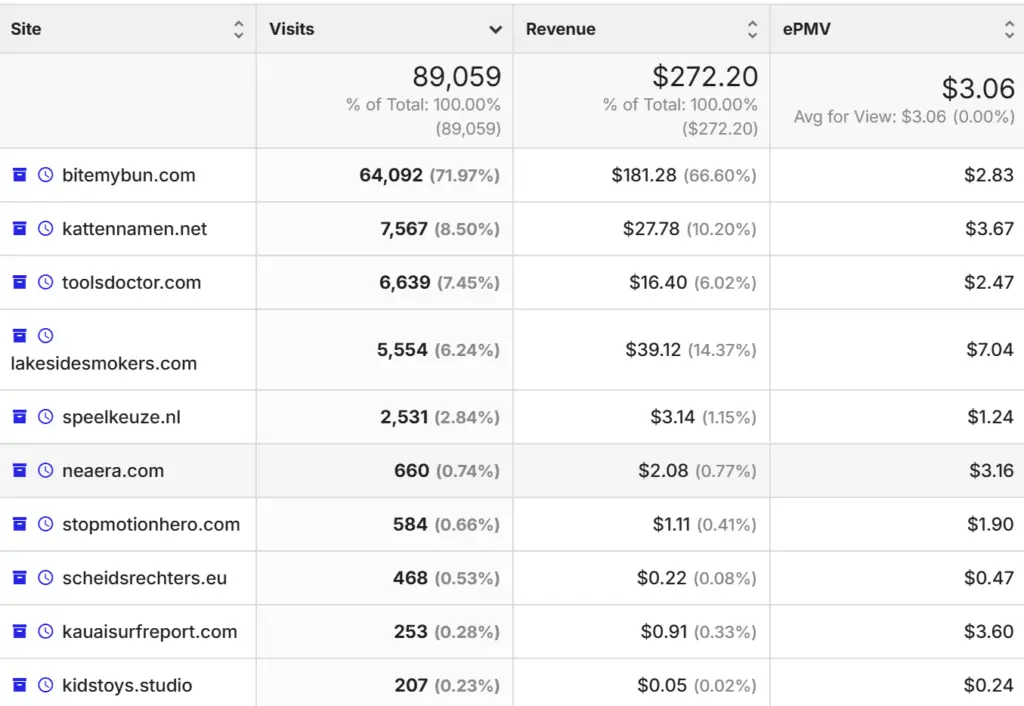
I recommend Ezoic for your display ads because they pay out a lot more than Adsense does, and they have a few essential tools to help your site grow, like LEAP site speed optimizer and NicheIQ.
Niche site P&L
| Network | Revenue |
| Amazon US | $9,607.58 |
| Bol.com | $97.37 |
| Own Products | $8.81 |
| Ezoic | $272.20 |
| Other Affiliate Programs | $0.00 |
| Other Amazon Storefronts | $166.38 |
| Youtube | $1,397.74 |
| Total income | $11,550.09 |
| Cost | -$3,860.75 |
| Profit | $7,689.33 |
Costs are stable but I made a few one time investments for products to review. That resulted in a profit of $7,689.33.
I’m really doing this full time now, and I’ve decided to stop working with outside writers and editors for a while because of the cost and until I can see the results of my semantic SEO strategy.
That way, I can devise a better strategy for what worked and what didn’t and educate writers and editors on the core concepts of semantic SEO.
Last month’s costs:
| Type | Cost |
| Accounting | $259.48 |
| Content | $0 |
| Hosting | $101.05 |
| Office | $78.37 |
| Onetime | $3,370.50 |
| Tools | $51.36 |
| Grand Total | $4,193.05 |
| Tools | Cost |
| Ezoic | $25.09 |
| Geniuslink | $26.27 |
| Grand Total | $51.36 |
The costs I’ve made over time:
Revenue diversification
This is my revenue diversification for this month:
Revenue Distribution
Revenue Diversification Over Time
Affiliate Revenue Distribution
Affiliate Revenue Diversification Over Time
Writing new content
We published 2 new articles in the last month. That’s because I’ve trained a few writers in how we want our articles published in semantic SEO and they are now up to speed for this new way of moving forward and getting through future Google Core Updates. But especially because I don’t want to publish anything during the core update. I want to change up my sites a lot and then initiate a re-ranking, and Google can’t do that when it’s focusing it’s computing power on the update.
The way I’m going to do that is by removing a lot of the pages in google search console from the crawled but not indexed page to reduce the overall cost of indexing, and publishing a new batch of articles around a closely knit semantic content network all at once.
So I’m confident that will be a good investment of resources and these articles will start picking up traction again. I’ll keep you posted.
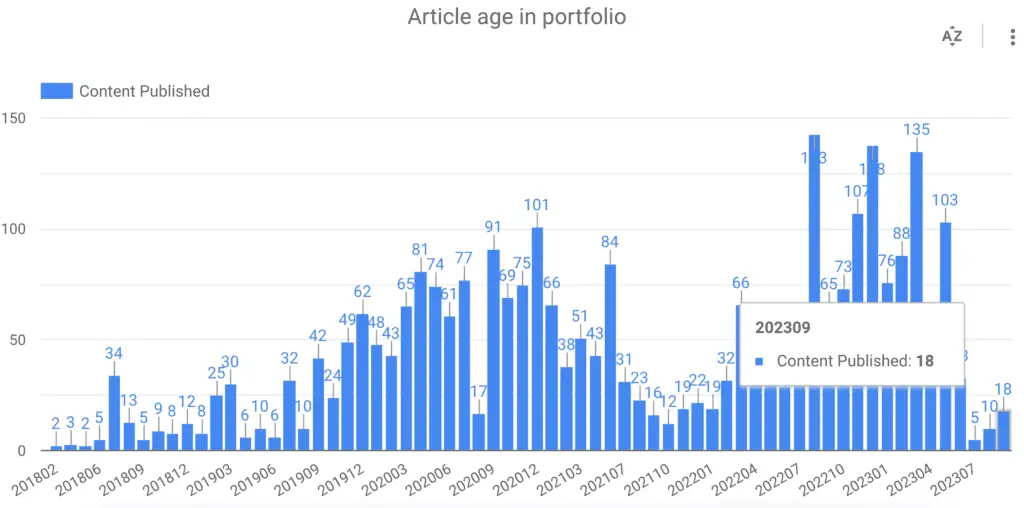
Traffic
Blog traffic has decreased overall and I’ve been winning the Google Core Update for March 2024 for none of my sites expect one, where I already made major changes to it after the helpful content update. It’s an affiliate site where I completely changed the way I write product reviews. With a complete scoring system of all products in a Google Sheet and printing scoring cards and comparison charts using python to generate the html.
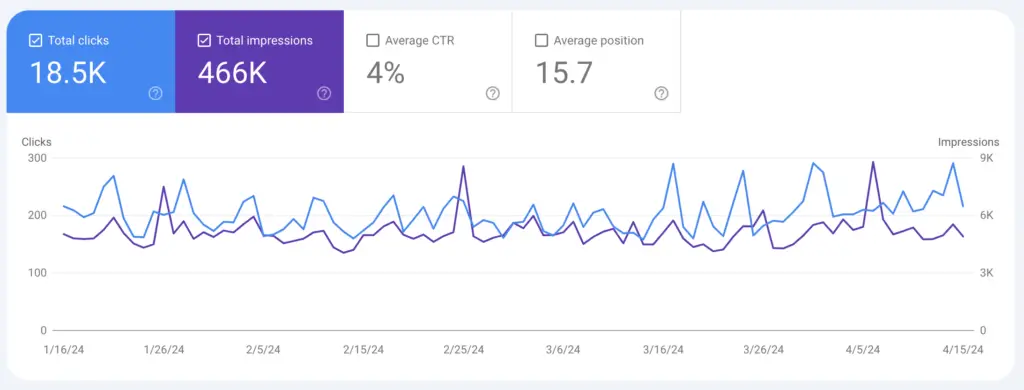
Goals for my blogs
I’ve made a few changes to my goals for the business. I don’t want to diversify to Youtube anymore per se.
It would be great to earn more from Youtube itself to diversify, but my efforts in writing content yield a lot better results.
Having just one main goal is the best to keep focus. So my goals are:
- My previous goal of getting to 1 million pageviews still stands; it’s when I finally can buy myself that new watch, and I will achieve this by February next year.
- My big audacious goal is to get to a quarter million in yearly revenue by the end of 2024 and half a million by the end of 2025.
My current blogging strategies
If I’m going to do this, I have to focus on just a few things. Youtube is not a large part of that.
I’ve also seen that focus helps with growing the blogs. It’s why I went from 24 sites to only 9 larger ones, and I think there’s still room to cut a few of them.
Investing in content for established blogs gives a much better return than content for newer blogs.
My current strategy is to write more around single entities and cover those completely.
I’ve seen great success with my topic cluster on kamaboko for bitemybun.com where most of the content ranked in under 2 months instead of 6.
It’s also part of what I discovered about answering smaller questions and what Google is rewarding my sites for since the last Google Core Update.
It’s great to invest in a new site to get it up and running, but there has to come a point where it needs to stand on its own.
Otherwise, it’s just like doing seed rounds for your startup that never makes any money in the hope you can sell it for a nice multiple.
But I’m here to create and hold these sites, not to flip them. The decisions for my business should reflect that, and I do want more than just a couple of niche sites. I want to become the authority in a few fields I’m really interested in.
I’d love it if people came up to me and asked me advice about that niche, like with Japanese food, guitars, and toys. My hobbies and I just love playing with my son to try out these toys.
But I know I’ve invested a lot in the last few months and that takes time to pay off. Creating these authority sites is in a way a lot different than creating smaller niche sites on underserved topics.
Eventually, you’ll need to prove to Google that you’re worth the traffic.
I believe in a quality threshold where Google needs to trust your site to be able to give it good positions for larger keywords. I’ve read a lot about it and seen it with my sites bitemybun and speelkeuze.
So that’s why I’m building authority and trust and topical coverage for my sites.
Past months
May 2023: Better blogging analytics with Google Datastudio
Google Search Console data is notoriously hard to get out of the tool and I wanted to get that data to see how to upgrade old content by using the right keywords, so I added those to a Google Data Studio dashboard (or I should say Lookerstudio because they rebranded).
Here I can see all the keywords a particular page ranks for and how many clicks it gets from those.
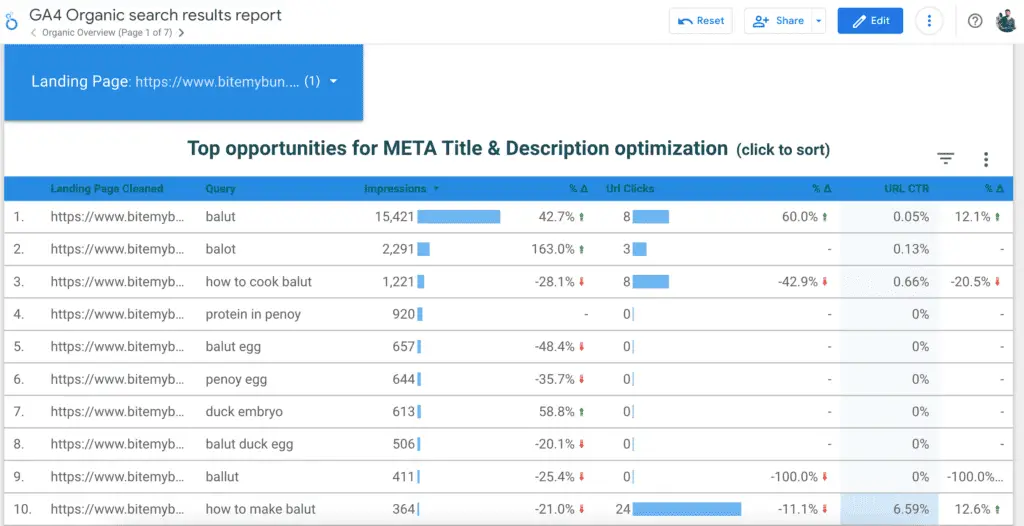
And here I can see which keywords I should focus on. Keywords that are almost in the top 3 in the SERP and get a decent amount of traffic.
I’ve added the average position in here as well as the amount of impressions a keyword gets. Then in the right most columns I can see the current click-through-rate in the SERPs.
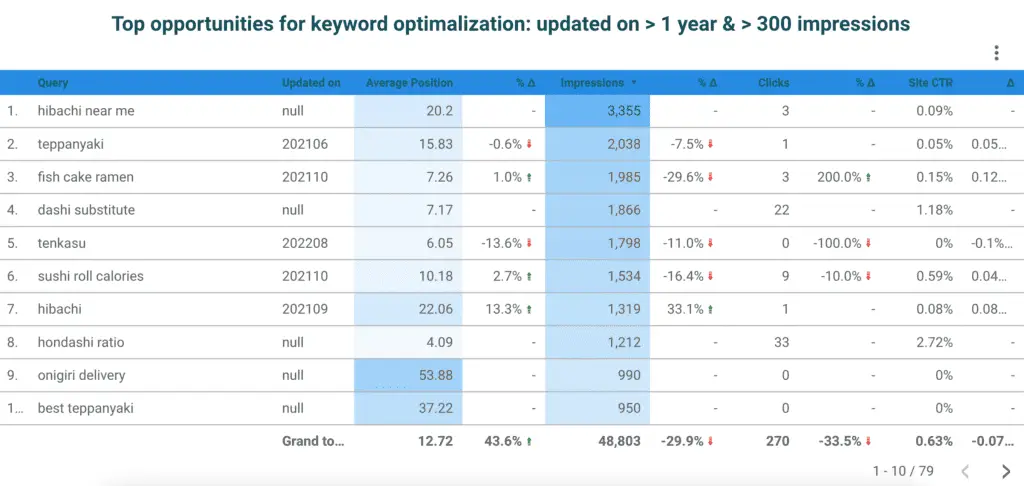
I’ve connected this to a Google Sheet, so I can track which articles I’ve already worked on so my team and I know which ones still need upgrading, but I’m not completely satisfied with this solution, so I might turn all of this into a separate application so all of you can use this as well.
April 2023: Integrating directly with OpenAI’s API instead of paying for tools
Fortunately I’ve still kept costs low by integrating my workflow directly with OpenAI’s API instead of using a tool like Jasper for the first drafts of articles with AI content and I’ve built out my own SaaS for our Dutch articles.
That saves a lot of money and is also way more efficient. I’ve been investing heavily into AI content for entities and tying all of the articles on the sites together. I’ll show you the first traffic results later.
With decreasing income in these times, at least in my niches, we have to find ways as bloggers to reduce costs while still producing great content.
And this last month there have been no yearly payments for tools I use like Grammarly or Gtranslate. But I did get a notice from Copytrack that one of the sites I bought last year had an image on it I didn’t have the copyright to, so that’s a large expense of €400 that I didn’t budget for.
Those guys don’t mess around, but it was indeed an image from another blogger so I’ve definitely learned to be more careful when it comes to buying blogs and the images that are on there.
March 2023: Adding entities to increase topical authority
I’ve been using AI to write about entities and increase the topical authority of my sites.
Especially for the sites where I’ve implemented the AI entity strategy first, you can really start seeing the results now for those investments in content I made earlier this year.
For stopmotionhero I started implementing the AI entity strategy at the beginning of January:
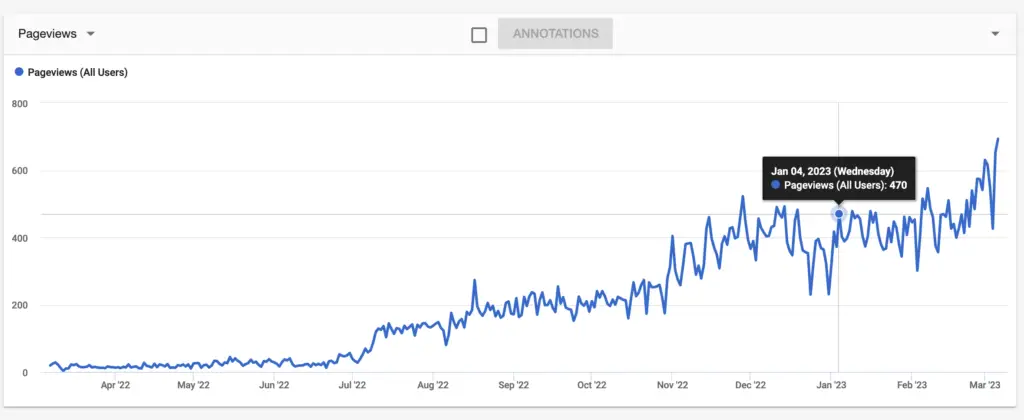
And for neaera you can see the same sharp increase in traffic after implementing this strategy, so it looks promising.
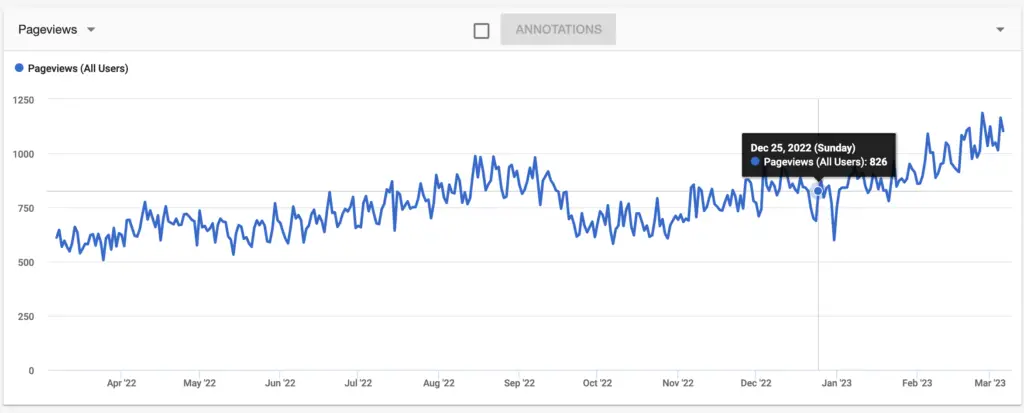
I only have the AI writer for writing large blog posts in a click available in Dutch at the time, but let me know ([email protected]) if you’d like to see it in English as well and I can start creating that for you guys.
November 2022: Started seeing a sharp decline
A few of my largest sites starting losing a lot of traffic, big chunks at a time.
I did a deep-dive into the reasons for losing that traffic, and it isn’t just the core updates targeting fluff.
I found Google was rewarding my recipes posts, and people also ask small question articles, but was completely ignoring me for larger topics.
We’ve started writing more Google People Also Ask kind of articles and more around one particular topic. That seems to work best.
I’ve also started to fill in the content gaps on the sites this month by writing a lot about entities and that tactic is already paying off when you look at the traffic from the last couple of weeks.
September 2022: Adding Geniuslink choice pages & my own book
August 2022 was all about diversifying Amazon income to earn from all of the different storefronts.
I had earned $6,942 and this month that grew to $7,698. That’s an 11% growth, not bad.
Amazon is the largest retailer in the US and bol.com does that in The Netherlands. So I’m reliant on these mega powers to continue to send me checks.
If you run a business and you have freelancers to pay for content, depending on just a few partners can be quite dangerous and it isn’t a great feeling when I think about it, depending on one entity so much.
In September 2022, I started diversifying affiliate revenue even more, but the tool I was trying didn’t work out.
I was trying out Datafeedr to get automatic product and price updates into my site, but it wasn’t stable enough to implement further, although I put a lot of effort into that.
Now I’m looking at Geniuslink choice pages to increase my affiliate revenue. It’s a bit more manual labor to get those up, but I’ve tested it before, and it does work if you use the right affiliate programs.

Where’s the EPMV the highest?
My largest site is bitemybun.com, about Asian food, so it’s only natural for me to try and grow that into an authority site.
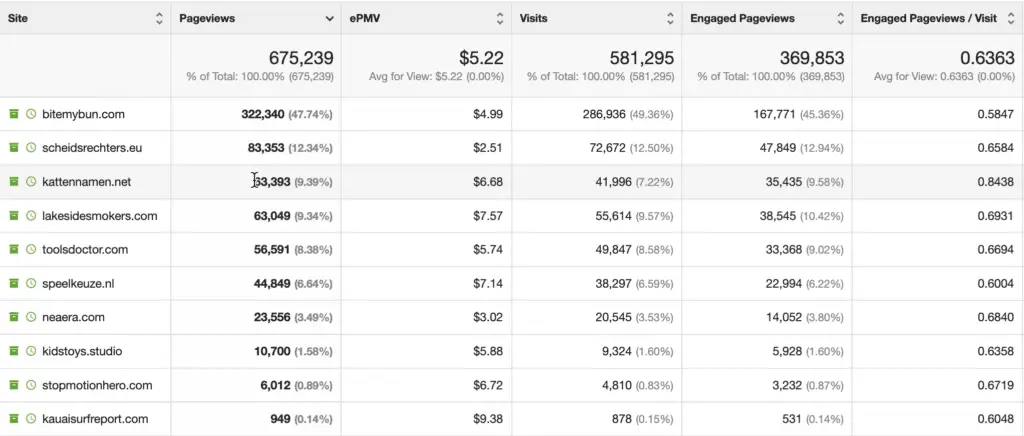
This is data you can get from Ezoic when you sign up with them to do your display ads, check out more info on the analytics here.
Bitemybun has by far the most pageviews, although its EPMV or earnings per thousand visitors is a bit lower than some of my other sites.
Advertisers pay less for content about Japanese food than they do for content about BBQ smokers, because when you have a smoker, you probably have a backyard, own your house, have money to spend on expensive equipment, and are generally more valuable to an advertiser of any kind.
Not just around that topic.
Plus I get a lot of traffic from outside the US on this site, which also makes sense given the topic.
Advertisers pay less for non-US traffic than they do if they target US citizens, although European EPVMs have risen a lot in the last three years too.
So on the one hand I want to grow traffic to a million pageviews, but on the other I want to get to 40% profitability in the next two months.
That’s a bit of a balancing act to see where I can grow the fastest and earn the most.
I did add a new revenue stream to bitemybun.com by introducing my own product.
I wrote a book, or rather had a book ghostwritten, about Japanese food. So now I’m an author on amazon.
I already earned $39 last month from the royalties, plus I’ve earned a few dollars more from promoting my book through my amazon affiliate link, which they allow you to do.
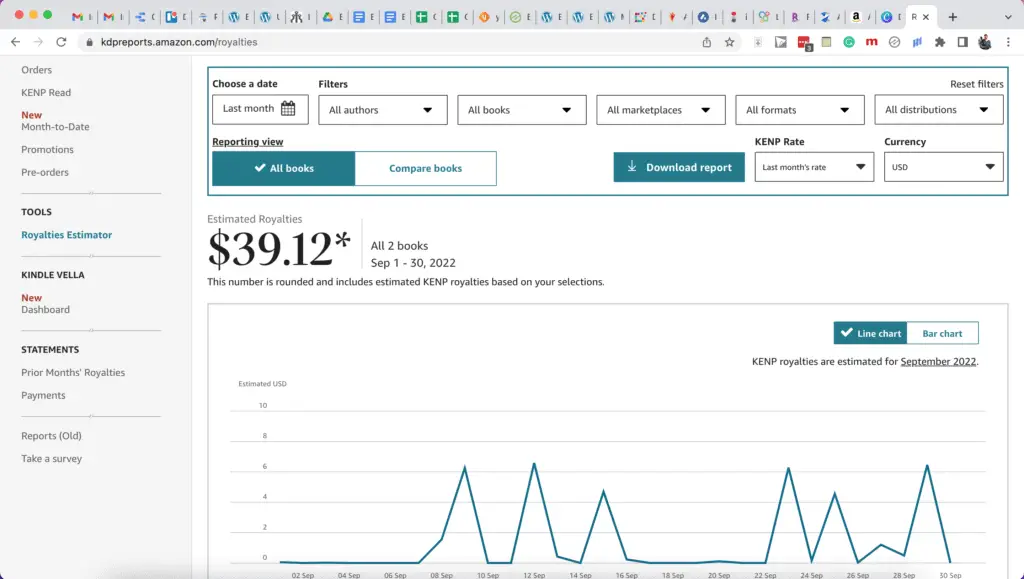
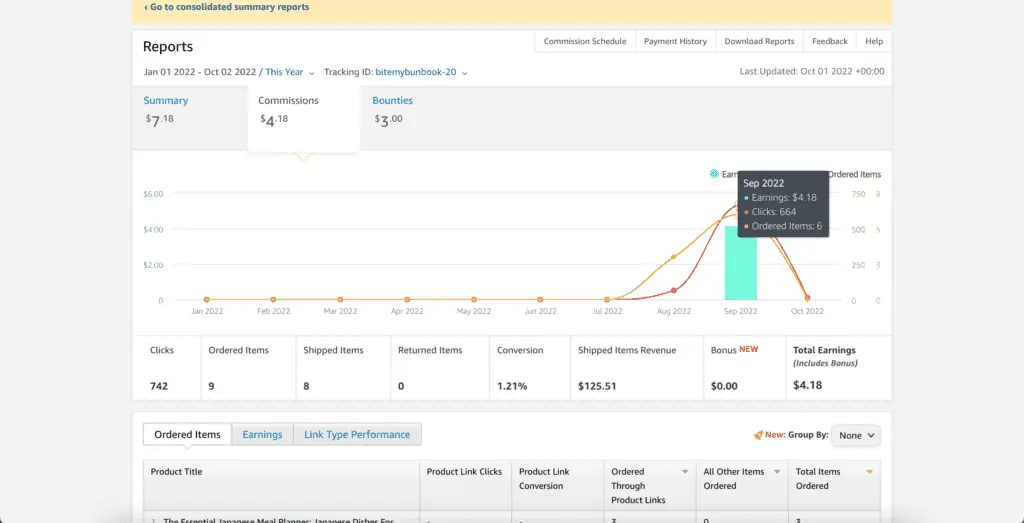
So I can get “two flies with one clap” as we say in The Netherlands.
I’ll promote the book more with my email newsletter in the coming months so I can take advantage of that and gaining more traffic for that site give me more opportunities to sell that and increase my total ePMV for the site, not just from ads on there.
Total EPMV is all of the revenue combined divided by the number of pageviews.
You need to take that into account when evaluating a site’s revenue. Affiliate sites can get a lot higher EPMV for example.
I’m also increasing EPMV with my own products, starting with the book.
August 2022: Introducing Geniuslink
This month, I had to let go of a content upgrader I’ve been working with for a while now, and she was doing a great job editing and upgrading our older content.
That’s the sort of thing that can have you lose hope and have your “courage sink into your shoes”, as we sometimes say here in the Netherlands.
Let’s look at what saved me from further disaster and grew my revenue for a great ROI, something you can do as well. because that last tool has a large part in it.
This is my affiliate revenue, and you can see I’m already diversified between Amazon and Bol.com, a Dutch multi-retailer platform.
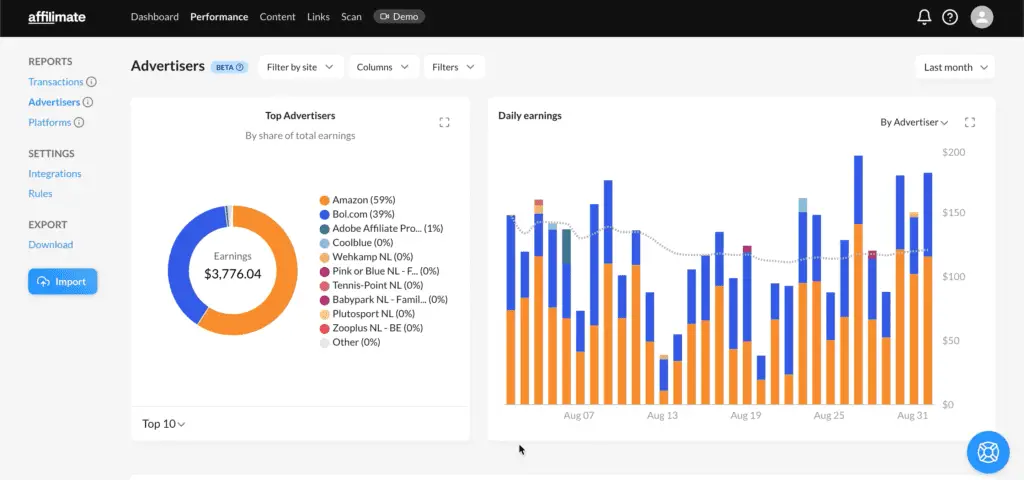
I’ve wanted to diversify my affiliate revenue even more, and I have plans for that, and the first step is within Amazon.
Sometimes, earning more revenue comes from experimenting. And this one paid off.
I introduced something that diversified my revenue even further and actually increased it by $875.97 just by using one tool.
Let’s decode this some more.
Amazon earnings were $2,235, but only $1,377 came from Amazon US. The rest came from other storefronts.
More than a third of my sales came from European countries like The Netherlands and Germany, but also some from Australia, Poland, and Japan.
| Amazon storefront | Revenue |
| US | $1,377.04 |
| UK | $35.28 |
| DE | $115.35 |
| FR | $153.15 |
| JP | $4.73 |
| CA | $39.90 |
| IT | $49.61 |
| ES | $38.63 |
| AU | $20.71 |
| NL | $367.68 |
| SE | $47.23 |
| PO | $3.70 |
| Total Amazon revenue | $2,253.01 |
You can localize storefronts with amazon’s tool Onelink, but that only works for a few of them, like the UK and Canada.
The tool I’m using is called Geniuslink, and it connects all of the world’s storefronts in one place.
It’s also more accurate than Amazon’s redirection.
You know when you sometimes click an amazon link, and you’re taken to a search page instead of a product page? That’s bad redirection, and Geniuslink claims to do that 50% better.
I haven’t tested that myself, but the results are great. I paid $73 for the tool and increased my revenue by $875. That’s an ROI of more than 1,000%!
Ok, let’s say the redirection doesn’t perform better than Onelink. I still have an extra $443 revenue from these countries that Onelink doesn’t provide, still giving me an ROI of 500%.
I’ll take that any day of the week.
Diversifying, growing the sites, and adding more revenue streams will be my main focus.
The dashboard I showed you earlier is from Affilimate, which gathers all my affiliate revenue in one place.
I have a lot of smaller platforms here with just $10 to $20 here and there, and I want to diversify affiliate revenue more in the coming months, but more on that in the next revenue report.
I’ve also thinned out my portfolio of sites to only focus on the bigger ones and grow those into authority sites. I’ve been working a lot on bitemybun.com to grow it into the biggest site in Japanese food so that’s my big audacious goal.
Also, read this article to see how I wrote a 24 article topic cluster in 24 hours for that site to please the google quality content update.
Joost Nusselder is The Content Decoder, a content marketer, dad and loves trying out new tools en tactics. He's been working on a portfolio of niche sites since 2010. Now since 2016 he creates in-depth blog articles together with his team to help loyal readers earn from their own succesful sites.
